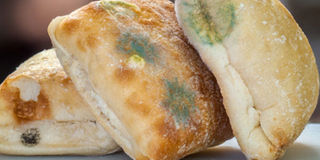How dangerous is mould on food?

What you need to know:
Although you may only see a few spots of the fungus, its tiny roots spread quickly through porous bread. Therefore, do not try to scrape off mould. According to drweil.com, some moulds produce poisons called mycotoxins to which long-term exposure increases cancer risk.
Often times, you want to choose between being safe but also not needlessly wasteful. Some people think that the spots of mould can simply be scraped off and the rest of the loaf is safe to eat. However, moulds are fungi which survive by breaking down and absorbing the nutrients of the material on which they grow, such as bread.
Amanda Tumwebaze, a nutritionist, says the white, yellow, green, gray, or black spots on bread are colonies of spores by which fungus reproduces. Spores can travel through the air inside the package and grow on other parts of the bread.
Do not scrape
Although you may only see a few spots of the fungus, its tiny roots spread quickly through porous bread. Therefore, do not try to scrape off mould. According to drweil.com, some moulds produce poisons called mycotoxins to which long-term exposure increases cancer risk.
Another type of fungi (moulds) affect drying food produce with low moisture content. As the food dries, these fungi find themselves suitable water content and, together with suitable temperatures, they grow and multiply.
According to Prof Archileo Kaaya, the head of the Department of Food Technology and Nutrition, Makerere University, “Not even cooking or roasting of the produce can destroy the toxins. Besides, these toxins are not visible and do not have any smell, making it difficult to detect their presence in food.”
How contamination occurs
According to Prof Kaaya, soil is the best medium for microorganisms. When farmers dry their food produce on the bare ground, it increases the risk of moulds developing in the produce. He says some farmers leave the produce, especially maize, in the garden. Since there is heat during day and dew in the night, mould grows on the maize to produce aflatoxins.
Sometimes the foods are not dried to the right moisture content before storage; and poor storage for example heaping produce such as maize inside the house or in a granary, creates an environment for the growth of mould.
Complications
If one consumes food that has very high levels of aflatoxins, they can suffer from acute toxicity according to Tumwebaze.
The cases of toxicity present with jaundice, abdominal pain, vomiting, diarrhoea and ascites (the abnormal buildup of fluid in the abdomen).
Tumwebaze says, “Consuming foods containing aflatoxins exposes an individual to chronic toxicity which is likely to cause cancer, especially of the liver which the commonest that is caused by aflatoxins. Liver cancer in Uganda is on increase!”
The toxins can cause stunting in infants. In Uganda, about 29 per cent of children below five years are reported to have stunted growth and, aflatoxins are suspected to be one of the contributing factors.
Aflatoxins also deny the body from receiving nutrients such as zinc, iron, proteins and some vitamins thereby lowering its immunity enhancing opportunistic diseases like HIV and malaria. They also can lead to kwashiorkor in children.
Tips to control mould
Mould spores from mouldy foods can build up in the refrigerator, dishcloth and other cleaning utensils. Follow these tips to control or reduce mould:
•Keep dishcloths, towels, sponges and mops clean and fresh. If they smell musty, they are spreading mould. Throw away any of these items that you cannot keep clean.
•Check items such as bread and fresh produce before you buy them. Keep a keen eye on the expiry date.
•Check out cured meats and poultry.




